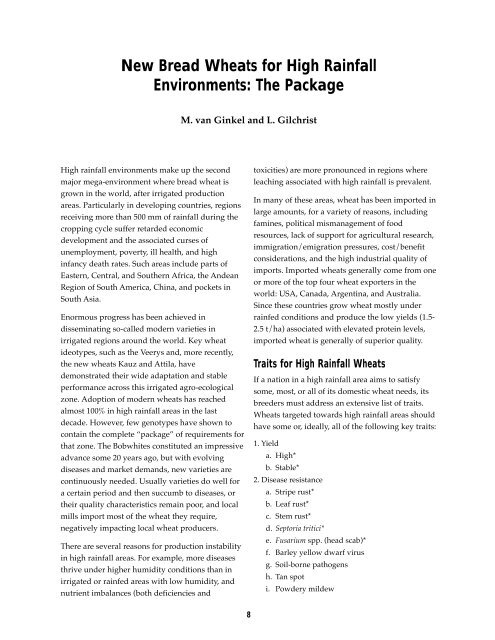Research Highlights of the CIMMYT Wheat Program 1999-2000
Research Highlights of the CIMMYT Wheat Program 1999-2000
Research Highlights of the CIMMYT Wheat Program 1999-2000
You also want an ePaper? Increase the reach of your titles
YUMPU automatically turns print PDFs into web optimized ePapers that Google loves.
New Bread <strong>Wheat</strong>s for High Rainfall<br />
Environments: The Package<br />
M. van Ginkel and L. Gilchrist<br />
High rainfall environments make up <strong>the</strong> second<br />
major mega-environment where bread wheat is<br />
grown in <strong>the</strong> world, after irrigated production<br />
areas. Particularly in developing countries, regions<br />
receiving more than 500 mm <strong>of</strong> rainfall during <strong>the</strong><br />
cropping cycle suffer retarded economic<br />
development and <strong>the</strong> associated curses <strong>of</strong><br />
unemployment, poverty, ill health, and high<br />
infancy death rates. Such areas include parts <strong>of</strong><br />
Eastern, Central, and Sou<strong>the</strong>rn Africa, <strong>the</strong> Andean<br />
Region <strong>of</strong> South America, China, and pockets in<br />
South Asia.<br />
Enormous progress has been achieved in<br />
disseminating so-called modern varieties in<br />
irrigated regions around <strong>the</strong> world. Key wheat<br />
ideotypes, such as <strong>the</strong> Veerys and, more recently,<br />
<strong>the</strong> new wheats Kauz and Attila, have<br />
demonstrated <strong>the</strong>ir wide adaptation and stable<br />
performance across this irrigated agro-ecological<br />
zone. Adoption <strong>of</strong> modern wheats has reached<br />
almost 100% in high rainfall areas in <strong>the</strong> last<br />
decade. However, few genotypes have shown to<br />
contain <strong>the</strong> complete “package” <strong>of</strong> requirements for<br />
that zone. The Bobwhites constituted an impressive<br />
advance some 20 years ago, but with evolving<br />
diseases and market demands, new varieties are<br />
continuously needed. Usually varieties do well for<br />
a certain period and <strong>the</strong>n succumb to diseases, or<br />
<strong>the</strong>ir quality characteristics remain poor, and local<br />
mills import most <strong>of</strong> <strong>the</strong> wheat <strong>the</strong>y require,<br />
negatively impacting local wheat producers.<br />
There are several reasons for production instability<br />
in high rainfall areas. For example, more diseases<br />
thrive under higher humidity conditions than in<br />
irrigated or rainfed areas with low humidity, and<br />
nutrient imbalances (both deficiencies and<br />
toxicities) are more pronounced in regions where<br />
leaching associated with high rainfall is prevalent.<br />
In many <strong>of</strong> <strong>the</strong>se areas, wheat has been imported in<br />
large amounts, for a variety <strong>of</strong> reasons, including<br />
famines, political mismanagement <strong>of</strong> food<br />
resources, lack <strong>of</strong> support for agricultural research,<br />
immigration/emigration pressures, cost/benefit<br />
considerations, and <strong>the</strong> high industrial quality <strong>of</strong><br />
imports. Imported wheats generally come from one<br />
or more <strong>of</strong> <strong>the</strong> top four wheat exporters in <strong>the</strong><br />
world: USA, Canada, Argentina, and Australia.<br />
Since <strong>the</strong>se countries grow wheat mostly under<br />
rainfed conditions and produce <strong>the</strong> low yields (1.5-<br />
2.5 t/ha) associated with elevated protein levels,<br />
imported wheat is generally <strong>of</strong> superior quality.<br />
Traits for High Rainfall <strong>Wheat</strong>s<br />
If a nation in a high rainfall area aims to satisfy<br />
some, most, or all <strong>of</strong> its domestic wheat needs, its<br />
breeders must address an extensive list <strong>of</strong> traits.<br />
<strong>Wheat</strong>s targeted towards high rainfall areas should<br />
have some or, ideally, all <strong>of</strong> <strong>the</strong> following key traits:<br />
1. Yield<br />
a. High*<br />
b. Stable*<br />
2. Disease resistance<br />
a. Stripe rust*<br />
b. Leaf rust*<br />
c. Stem rust*<br />
d. Septoria tritici*<br />
e. Fusarium spp. (head scab)*<br />
f. Barley yellow dwarf virus<br />
g. Soil-borne pathogens<br />
h. Tan spot<br />
i. Powdery mildew<br />
8

















